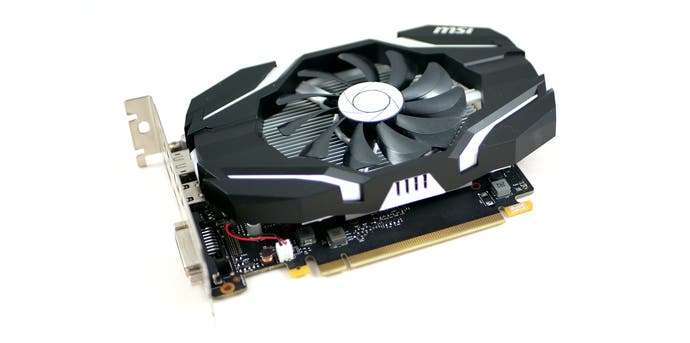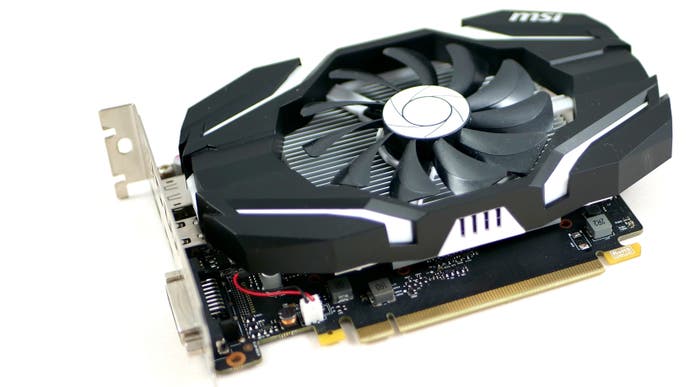Nvidia GeForce GTX 1050 2GB benchmarks: a good budget card but it needs more RAM
And a three gig version is available now...
Nvidia's GeForce GTX 1050 2GB is the cheapest 10-series card on the market that we can recommend right now, offering better raw performance than the AMD graphics cards built into the base PlayStation 4 and Xbox One models. However, the card does suffer from its rather limited video memory, meaning that most gamers are likely to be better served by a higher-end card with 3GB of VRAM or more.
In this comparison of the best graphics cards on a budget, we're measuring up the GTX 1050 2GB against its value-orientated competitors - the GTX 1050 3GB, two flavours of AMD's Radeon RX 560 and the current top dog when it comes to budget GPUs, the GTX 1050 Ti. This Nvidia card features more memory and the fully enabled version of the GP107 processor found in the 1050, making it a better performer in all games than either GTX 1050 model. However, it also costs more, so on balance the 3GB version of the GTX 1050 could be the better choice pound for pound.
Meanwhile, the situation with the RX 560 is complicated to say the least. Two versions of the silicon are available, featuring 14 and 16 compute units, respectively. On top of that, any given model may have two or four gigabytes of memory and PCI Express power connections or not - and you can expect limited overclocking and lower boost clocks without it. For our money, we can only really recommend the four gigabyte version of the RX 560, so that's what we've included in our benchmark results. To give some idea of the difference between the 14 and 16 compute unit versions, we've tested both at the same clock speeds - although of course, clocks can also vary from model to model.
Which GPUs are worth buying? We've made our picks for the best graphics cards available, updated with the latest graphics cards as they're released. As well as an overall performance champ, we name the best value graphics card and best cheap graphics card to guide your next upgrade.
The picture here is fascinating. Our tests are not overly demanding, but you will still see some big differences between the GTX 1050 2GB, GTX 1050 3GB and GTX 1050 Ti 4GB when it comes to frame-rates - and these results can only be explained by the lower-end card simply running out of VRAM. The GTX 1050 2GB remains a very capable budget card overall, and if you're happy to lower texture quality presets, it'll serve you just fine. However, as the 3GB version of the card has become available, there is little reason to go with the 2GB model if they're similar in price. If there is a bit of a gap, then these benchmarks should help you decide which is the more worthwhile choice.

| GPU cores | Boost clock | TFLOPS | Memory | Memory Bandwidth | |
|---|---|---|---|---|---|
| GTX 1050 2GB | 640 | 1455MHz | 1.8 | 2GB GDDR5 | 112GB/s |
| GTX 1050 3GB | 768 | 1518MHz | 2.3 | 3GB GDDR5 | 84GB/s |
| GTX 1050 Ti | 768 | 1392MHz | 2.1 | 4GB GDDR5 | 112GB/s |
| RX 560 (14 CUs) | 896 | 1275MHz | 2.6 | 2GB/4GB | 112GB/s |
| RX 560 (16 CUs) | 1024 | 1275MHz | 2.6 | 2GB/4GB | 112GB/s |
In the meantime, here's how the budget GPU landscape looks as we test the GTX 1050 2GB, GTX 1050 3GB, GTX 1050 Ti and our brace of RX 560s across a range of punishing games. The bar chart tables are simple enough to understand, but you can mouse-over every element for detailed performance differentials and remember that you can click the graph for performance expressed as a percentage - possibly a more meaningful way to compare. For granular telemetry on frame-rate and frame-time, start the video embed and watch the data play out before your very eyes. If you're viewing these words on mobile, you'll have to make do with a static version of these readings - but of course you're free to check this page later on a PC to get the full multimedia experience.
Assassin's Creed Unity
We begin with the VRAM-intensive Assassin's Creed Unity. This 2014 title shows off the dangerous avenues and slick rooftops of Paris on the cusp of revolution. The GTX 1050 2GB outperforms both of the RX 560 variants here by between five and nine per cent, but falls significantly behind the GTX 1050 3GB and GTX 1050 Ti 4GB as the card struggles with keeping all of these high-res textures in memory at once. On average, the GTX 1050 3GB is seven per cent ahead, while the GTX 1050 Ti gets a significant 15 per cent boost over the 2GB 1050 card.
AC Unity: 1080p, Ultra High, FXAA
Ashes of the Singularity
Ashes of the Singularity, a strategy game released in 2016, is one of the few DirectX 12 benchmarks in our test suite. The game's shiny lasers and hovering vehicles provide a good challenge for these low-end cards even at 1080p, thanks to the extreme graphics preset we're using here. The 1050 2GB comes in last place this time, trailing behind the 1050 Ti by 29 per cent and behind the GTX 1050 3GB by 16 per cent. Meanwhile, both RX 560 flavours record just a few frames more per second than the 1050 2GB; AMD often gets an extra advantage from DX12 and this is borne out here.
Ashes of the Singularity DX12: 1080p, Extreme, No AA
Battlefield 1
Battlefield 1 is the first game that really brings the GTX 1050 2GB to its knees. The 1050 records an average frame-rate of just 12fps here, with every other card in the test managing around 50 frames per second or better - a pretty disheartening result. We turned down settings to high on the GTX 1050 2GB and still got the same results. Ultimately, the lowly medium preset under DX11 is the way forward if you're interested in playing this particular title. Thankfully, the extra gigabyte of RAM on the new GTX 1050 model means that it performs a ridiculous four times better, with an average frame rate of 48fps. If you're interested in playing this game, we recommend the 3GB card or accepting a significant graphical fidelity sacrifice.
Battlefield 1: 1080p, Ultra, TAA
Crysis 3
The GTX 1050 2GB returns to form in the next test, 2013 title Crysis 3, which thankfully doesn't require more than two gigs of VRAM while gaming at 1080p. The game is still challenging, even at full HD resolution, but the GTX 1050 2GB is able to stave off VRAM concerns to record a playable frame-rate of 43fps. That's even faster than the 42fps recorded by the 3GB card, which is constrained by its lower video memory bandwidth. The 43fps achieved by the 2GB card is around 14 and 18 per cent higher than the different RX 560 variants, making for a respectable result. However, the GTX 1050 Ti remains ahead by a strong margin with an average frame-rate of 47fps.
Crysis 3: 1080p, Very High, SMAA T2X
The Division
Our next DirectX 12 benchmark is 2016's The Division. The GTX 1050 2GB falls to last place once again, but with a slightly more playable frame-rate of 22fps, behind the RX 560s and the GTX 1050 Ti. The 3GB version of the card fares much better, with an average result of 31fps. If you switch to the DirectX 11 setting in the game, you should expect marginally better performance in both Nvidia GPUs, but it won't be enough for the GTX 1050 2GB to draw level with the AMD cards. It is worth stressing that we're pushing ultra settings here - medium/high will deliver a much improved performance level. The 1050 2GB has memory limitation issues once again - streaming geometry and textures in the benchmark isn't properly resolved, something a barchart can't show you!
The Division DX12: 1080p, Ultra, SMAA
Far Cry Primal
Far Cry Primal came between the two mainline Far Cry games, Far Cry 4 in 2014 and Far Cry 5 in 2018. The game tends to favour Nvidia cards over AMD ones, and indeed we see that the GTX 1050 2GB is able to squeak out a commendable result just shy of 40fps at 1080p. That's better than the 3GB version of the card, which struggles once again to record an average frame-rate of just 37fps. The GTX 1050 Ti is just five per cent ahead of the 2GB card here, making this one of the closest results we've seen. Interestingly, we are running the high texture pack here which suggests you could see better performance without it enabled.
Far Cry Primal: 1080p, Ultra, SMAA
Ghost Recon Wildlands
Ghost Recon Wildlands is the most recent and most challenging game in our current test suite, particularly at the very high quality preset we're using here. Out of our four cards, the game runs best on the GTX 1050 Ti with a score of 40 frames per second. The GTX 1050 2GB's score is respectable, but still 13 per cent behind its Nvidia stablemate. The 3GB GTX 1050 does a little better, closing the gap to 10 per cent. The RX 560 cards bring up the rear yet again, with the better of the two cards recording a score 20 per cent worse than the GTX 1050 Ti. These results aren't great, but should be somewhat playable if you're willing to keep turning down graphical fidelity settings or you enlist the help of a FreeSync or G-Sync monitor to smooth out frame-rate variations.
Ghost Recon Wildlands: 1080p, Very High, TAA
Rise of the Tomb Raider
Rise of the Tomb Raider is another reasonable showing for the GTX 1050 2GB, with an average frame-rate of 40fps. That's just ahead of both AMD cards and just 15 per cent behind the GTX 1050 Ti and 9 per cent behind the GTX 1050 3GB. It's worth noting that the very high preset has been slightly amended to use high textures, which prevents low VRAM graphics cards from stuttering but it's not a complete success for the GTX 1050 - you'll note that its fps range is far wider than the other cards, signifying less consistency. Also, this benchmark flatters to deceive - actual gameplay frame-rates can be lower than the test suggests.
Rise of the Tomb Raider: 1080p, Very High, SMAA
The Witcher 3
Our final title is The Witcher 3, first released in 2015. The game's ultra preset is a tough one even without Hairworks enabled, but both GTX 1050 models are able to deliver a playable 36 frames per second on average. That's again higher than our AMD duo but lower than the GTX 1050 Ti which manages 41 frames per second. The worst five per cent and one per cent readings are really terrible on the RX 560 - there's a lot of noticeable stutter that simply isn't present on the Nvidia side, not even on the 2GB version of the GTX 1050.
The Witcher 3: 1080p, Ultra, POST-AA, No Hairworks
Cross-generational comparison
In this special comparison between generations, we'll look at performance in Assassin's Creed Unity see how the GTX 1050 2GB compares to its predecessors. Assassin's Creed Unity has been chosen for this test for two major reasons. Firstly, the amount of VRAM your graphics card has can limit its performance in games that keep a lot of textures in memory at once, and ACU is one of these games. Secondly, the ultra high preset, even using FXAA over more demanding anti-aliasing options, remains a staggering challenge for even modern graphics cards. You can use the Kepler, Maxwell and Pascal buttons to see just how the Nvidia cards of the same generation compare to one another, or leave everything in there to see the generational leaps.
Assassin's Creed Unity: 1080p, Ultra High, FXAA
Assassin's Creed Unity: 1080p, Ultra High, FXAA
Generational comparison
Finally, we'll see how the GTX 1050 2GB slots into the entire Nvidia 10-series lineup. Note that the 3GB version of the card slots in between the 2GB model and the 1050 Ti, but it's closer to the 2GB model than the more expensive Ti card.
Assassin's Creed Unity: 1080p, Ultra High, FXAA
Now that you've seen the benchmarks for one card, why not check out see which PC hardware we recommend to our friends and family? Here are the DF picks for the overall best graphics cards and for the best gaming monitors on the market.









